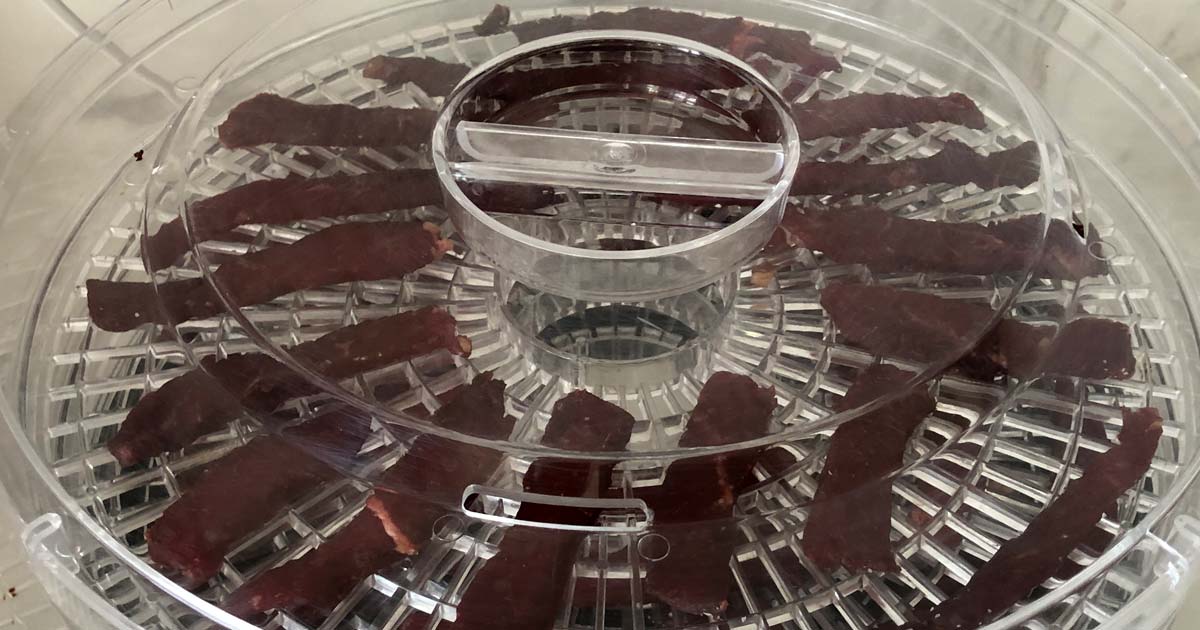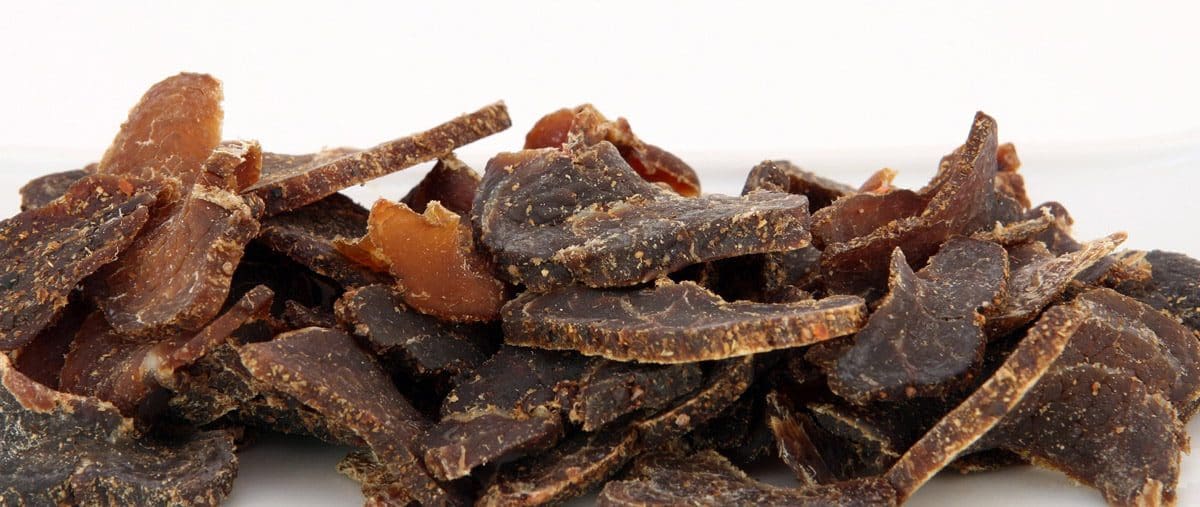Want to make jerky for your hikes?
Jerky is a nutrient-dense, convenient and shelf-stable meat product that has grown in popularity world wide. Derived from the Spanish word “charqui,” which describes dried meat strips, jerky may be produced using a combination of curing, smoking and drying procedures. Traditionally jerky was made by the use of sun, wind, and smoke from fires as a way to Jerky is a nutrient-dense, convenient, shelf-stable meat product that can be made from just about any type of raw meat ingredients. Its name is derived from the Spanish word “charqui,” which describes dried meat strips. Jerky is produced using combinations of curing, smoking and drying procedures.
Making jerky at home can be much more economical than buying it. Consider that buying a package of jerky costs around $3 per 50 grams. That is at least $71 per kilo for the finished product. Homemade jerky only requires the purchase of lean, whole-muscle cuts such as a rump roast or chuck tender roast, some simple ingredients and a little time. For example, if a rump roast has a retail price of $24 per kilo and you can make approximately 40 percent of the purchase weight of store-bought beef into jerky, your cost for homemade jerky would be $60 per kilo.
Traditionally, jerky was made using the sun, wind and smoke from fires to preserve and extend the shelf life of meat. Drying and smoking results in meat products that have a long storage life, allowing for the preservation of large amounts of meat that could be stored and consumed later.
Today jerky is produced from thin strips of meat (beef, pork, lamb, venison, poultry) or ground and formed meat. Many varieties of commercial seasonings are available for home jerky making, or you can develop your own recipes by following a few simple steps.
Meat Source
Jerky can be made using whole muscles or ground meats; however, for home processing, whole-muscle cuts are recommended because they result in a safer, more traditional jerky product.
Essentially, any meat source can be used to make jerky, but typically, lean cuts such as beef round roasts or pork loin are used. Lean cuts are more desirable because fat can become rancid during storage, resulting in off flavors.
Non Meat Ingredients
While the simplest jerky consists of dried meat, ingredients often are added to improve taste, color and texture. Salt is the most commonly added ingredient and is used to improve flavor, enhance the storage life and remove moisture from the product.
Occasionally, “cure” may be added to the raw meat. Cure is the ingredient nitrite, which typically is added as sodium nitrite, but it also may include sodium nitrate. Nitrite is used to fix the color of the jerky. Nitrite also is a potent antioxidant, which prevents spoilage during storage, and a flavor enhancer.
The amount of cure added is very small, in the parts per million range. When purchased, it usually is mixed with common table salt.
Commonly available curing salts include Complete Cure, Hi-Cure, and Ham Cure . These products are available at specialty stores. The nitrite-only products usually are pink so they are not confused with regular table salt. Be sure to follow instructions on the curing salts because excessive amounts may cause health problems.
Spices such as black pepper or garlic are other common ingredients. However, almost any spice can be added to a jerky formulation, resulting in a wide range of flavors. Other ingredients such as soy sauce, sugar, teriyaki or barbecue spice can be added to change the flavor.

Processing
Several methods can be used to make jerky. For whole-muscle jerky, the first step is to slice the meat thinly into strips no more than 6mm thick. Having the meat near frozen can make slicing easier. Colder meat also is better from a food safety perspective.
After slicing, other ingredients can be added. The best way to impart flavor into whole-muscle jerky is to use a brine or marinade.
For most home jerky production, raw, sliced meat is placed into boiling marinade to cook the meat before drying. If you have a smoker or cooker that can reach high enough temperatures to fully cook the meat, you can place the jerky into a non-boiling marinade and allow it to soak at refrigerator temperatures for four to twenty four hours.
If using a cooker or smoker to make jerky, be sure the product’s temperature reaches at least 70 C to ensure any bacteria are destroyed.
After marinating, jerky strips should be laid out in a pan or food dehydrator in a single layer. If using a food dehydrator, be sure the temperature can be set high enough to fully cook the meat. If using a smoker, the meat should be brought to a fully cooked temperature as smoke is applied.
Do not smoke the jerky at lower temperatures and finish at a higher temperature because some bacteria can survive the drying process and not be killed during cooking.
Food Safety Issues
Simply marinating and drying meat does not ensure that potentially harmful bacteria have been killed. Several types of bacteria can survive the drying process and cause food borne illnesses when the product is consumed. In almost every case, meat must be fully cooked before the drying process starts to kill harmful bacteria. In the past, food borne illnesses have been associated with the consumption of jerky, which prompted changes in recommendations for home jerky making. Commercially produced jerky products also have been linked to food borne illness outbreaks.
These illnesses have raised concerns about the safety of traditional drying methods for making jerky from meat and poultry at home. It is recommended that meat be heated to 70 C and poultry to 75 C before the dehydrating process to destroy pathogenic microorganisms.
In addition, take special precautions when making homemade jerky from venison or other wild game. Game, including venison and wild game birds, can become heavily contaminated with fecal bacteria, depending on the skill of the hunter in dressing the animal and location of the wound. Commercially processed carcasses usually are chilled rapidly, but game carcasses often are held at temperatures that could allow bacteria to multiply.
The general conclusion is that the meat needs to be heated prior to drying and that adding cure (sodium nitrite) to the formulation increases the destruction of bacteria, compared with jerky without added cure. When making whole-muscle jerky at home, sliced meat strips should be precooked in a hot marinade prior to drying. The hot marinade will destroy bacteria on the meat.
Food Safety Guidelines
Bacteria can spread through a work area and contaminate equipment and work surfaces. To reduce your risk of food borne illness:
- Wash your hands for at least 20 seconds with soap and water before beginning to work and after changing tasks or after doing anything that could contaminate your hands, such as sneezing or using the bathroom.
- Start with clean equipment and clean it thoroughly after using it. Be sure all surfaces that come into contact with meat and other jerky ingredients are clean.
- Sanitise surfaces with a solution of 1 tablespoon of chlorine bleach per gallon of water. Allow to air dry.
- If using frozen meat, thaw it in a refrigerator (at 4 C or below) on the lowest shelf to prevent juices from dripping on ready-to-eat foods. Never thaw meat on the kitchen counter.
- Use refrigerated ground meat within two days or whole red meats within three to five days.
- Keep raw meat separate from other foods.
- Marinate raw meat in the refrigerator.
- Steam or roast meat to 70 C and poultry to 75 C before dehydrating it.
- Dry meats in a food dehydrator that has an adjustable temperature dial and will maintain a safe temperature of at least 55 to 60 C throughout the drying process. Don’t rely on the dial settings when using a food dehydrator.
- Measure the temperature of the dehydrator with a calibrated thermometer during processing. Place the metal stem of a dial thermometer between dehydrator trays or create an opening for the stem by drilling a hole through the side of the tray.
*Use home-dried jerky within two months.

Jerky Marinade
¼ cup soy sauce
1 tbsp. Worcestershire sauce
¼ tsp. black pepper
¼ tsp. garlic powder
½ tsp. onion powder
1 tsp. hickory smoke-flavored salt
for 680-900 grams of lean meat such as beef, pork or venison
Jerky Making Procedures Using Marinade
- Prefreeze meat to be made into jerky so it will be easier to slice.
- Cut partially thawed meat into long slices no more than 6mm thick. For tender jerky, cut the meat at right angles to long muscles (across the grain). Remove as much visible fat as possible to help prevent off flavors.
- Prepare 2 to 3 cups of marinade of your choice in a large sauce pan.
- Bring the marinade to a full rolling boil over medium heat. Add a few meat strips, making sure they are covered by the marinade. Reheat to full boil.
- Remove pan from range. Using tongs, remove strips from hot marinade (work quickly to prevent overcooking) and place in single, non-overlapping layers on drying racks. (Repeat steps 4 and 5 until all the meat has been precooked.) Add more marinade if needed.
- Dry at 60 to 65 C in dehydrator, oven or smoker. Test for doneness by letting a piece cool. When cool, it should crack but not break when bent. The meat should not have any moist or underdone spots.
- Refrigerate the jerky overnight in plastic freezer bags, then check again for doneness. If necessary, dry further. Soaking the strips in marinade before precooking is not advised because the marinade could become a source of bacteria. Putting unmarinated strips directly into the boiling marinade minimises a cooked flavor and maintains the safety of the marinade.
Yield: 2.25kg of fresh meat should weigh approximately 1kg after drying.
Related articles
Dehydrating Vegetables for Hiking
Reference
Jerky Making: Producing a Traditional Food With Modern Processes
North Dakota State University
Robert Maddock, Ph.D., Associate Professor – Meat Science, Department of Animal Sciences, NDSU
Julie Garden-Robinson, Ph.D., R.D., L.R.D., Professor and Food and Nutrition Specialist, NDSU Extension Service; Martin Marchello, Ph.D., Professor Emeritus, Department of Animal Sciences, NDSU





